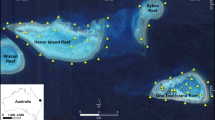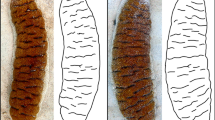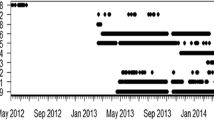Abstract
For reef fishes that do not move between habitat patches following settlement, habitat selection is expected during settlement. Although false clown anemonefish, Amphiprion ocellaris, are sedentary following settlement, they are not especially discriminating during settlement, and are commonly found occupying anemones at which no apparent nest site exists. In this study I report on mobility of Stichodactyla gigantea sea anemones, including anemones with resident false clowns. I argue that anemone mobility can help explain why settling false clowns are not more discriminating: although the per annum probability of an anemone moving is low, the probability of that anemone moving over the course of a resident's life is considerably higher. Therefore, an anemone's current microhabitat may not be a good predictor of its microhabitat and suitability as a host in the future.
Similar content being viewed by others
References cited
Allen G.R. 1972. The Anemonefishes: Their classification and Biology. T.F.H. Publications, Neptune City. 288 pp.
Arvedlund, M., M.I. McCormick, D.G. Fautin, & M. Bildsøe. 1999. Host recognition and possible imprinting in the anemone-fish Amphiprion melanopus (Pisces: Pomacentridae). Mar. Ecol. Prog. Ser. 188: 207-218.
Arvedlund, M., I. Bundgaard & L.E. Nielsen. 2000. Host imprinting in anemonefishes (Pisces: Pomacentridae): Does it dictate spawning site preferences? Env. Biol. Fishes 58: 203-213.
Booth, D.J. & G. Wellington. 1998. Settlement preferences in coral-reef fishes: Effects on patterns of adult and juvenile distributions, individual fitness and population structure. Aust. J. Ecol. 23: 274-279.
Caley, M.J., M.H. Carr, M.A. Hixon, T.P. Hughes, G.P. Jones & B.A. Menge. 1996. Recruitment and the local dynamics of open marine populations. Ann. Rev. Ecol. Syst. 27: 477-500.
Elliott, J.K., J.M. Elliott & R.N. Mariscal. 1995. Host selection, location, and association behaviors of anemonefishes in field settlement experiments. Mar. Biol. 122: 377-389.
Fautin, D.G. 1991. The anemonefish symbiosis: What is known and what is not. Symbiosis 10: 23-46.
Fautin, D.G. & G.R. Allen. 1992. Field Guide to Anemonefishes and their Host Sea Anemones. Western Australian Museum, Perth. 160 pp.
Fukui, Y. 1973. Some experiments on the symbiotic association between sea anemone and Amphiprion. Publ. Seto Mar. Biol. Lab. 20: 419-430.
Hattori, A. 1995. Coexistence of two anemonefishes, Amphiprion clarkii and A. perideraion, which utilize the same host sea anemone. Env. Biol. Fishes 42: 345-353.
Lubbock, R. 1980. Why are clownfishes not stung by sea anemones? Proc. R. Soc. Lond. B 207: 35-61.
Mariscal, R.N. 1972. Behaviour of symbiotic fishes and sea anemones. pp. 327-360. In: H.E. Winn & B.L. Olla (ed.) Behaviour of Marine Animals, Volume 2, Plenum Press, New York.
Moyer, J.T. 1980. Influence of temperate waters on the behavior of the tropical anemonefish Amphiprion clarkii at Miyake-jima, Japan. Bull. Mar. Sci. 30: 261-272.
Moyer, J.T. 1986. Longevity of the anemonefish Amphiprion clarkii at Miyake-jima, Japan with notes on four other species. Copeia 1986: 135-139.
Nelson, J.S., V.P. Phang & L.M. Chou. 1996. Survival and growth rates of the anemonefish Amphiprion ocellaris: A transfer experiment. J. Fish Biol. 48: 1130-1138.
Nelson, J.S., L.M. Chou & V.P. Phang. 1998. Inter-habitat migration of the anemonefish Amphiprion ocellaris. Asian J. Trop. Biol. 3: 19-31.
Sale, P.F. 1980. The ecology of fishes on coral reefs. Oceanogr. Mar. Biol. Ann. Rev. 18: 367-421.
Schmitt, R.J. & S.J. Holbrook. 1996. Local-scale patterns of larval settlement in a planktivorous damselfish-do they predict recruitment? Mar. Freshw. Res. 47: 449-463.
Thresher, R.E. & A.M. Gronell. 1978. Subcutaneous tagging of small reef fishes. Copeia 1978: 352-353.
Author information
Authors and Affiliations
Rights and permissions
About this article
Cite this article
Mitchell, J.S. Mobility of Stichodactyla Gigantea Sea Anemones and Implications for Resident False Clown Anemonefish, Amphiprion Ocellaris . Environmental Biology of Fishes 66, 85–90 (2003). https://doi.org/10.1023/A:1023286009054
Issue Date:
DOI: https://doi.org/10.1023/A:1023286009054




